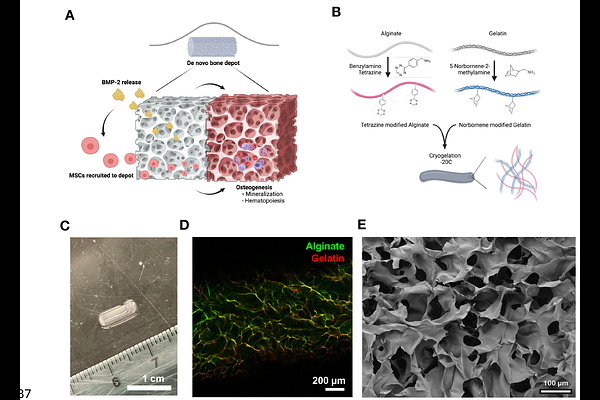Kinetics of de novo Bone and Bone Marrow Niche Formation with Hybrid Click Cryogels

Kinetics of de novo Bone and Bone Marrow Niche Formation with Hybrid Click Cryogels
Lee, S.; Adu-Berchie, K.; Sharda, A. S.; To, T.; Dimitrakakis, N.; Stafford, A.; Sheehan, K.; Johnson, C.; Ijaz, H.; Kwon, P.; Cartwright, M.; Elmehrath, S.; Skolfield, M. C.; White, D.; Williams, M.; Super, M.; Scadden, D. T.; Mooney, D. J.
AbstractSuccessful hematopoietic stem cell transplantation (HSCT) critically depends on efficient T cell recovery, which is limited by compromised bone marrow niches following irradiation. While various factors influence the regeneration of bone and bone marrow niches, the dynamics of this process remain elusive. Here, we explore the kinetics of de novo bone and bone marrow development under varying BMP-2 doses, host immune status, and biological sex, using a cryogel of covalently crosslinked alginate and gelatin releasing BMP-2. Bone formation was monitored by ultrasonography and microcomputed tomography (microCT) analysis, while histological analysis provided insights into the relation between mineralized tissue and bone marrow formation. Bone developed within 2-4 weeks, resulting in cortical bone around the cryogels, and a trabecular bone network with hematopoietic tissue within the cryogels. Higher BMP-2 doses significantly accelerated mineralization kinetics and doubled the resident hematopoietic stem cell population. Notably, immunocompromised status delayed niche development by two weeks and reduced hematopoietic stem cells fourfold. We also found that female mice exhibited enhanced niche formation compared to males under the identical conditions. These findings provide insights into the factors that govern the spatiotemporal regulation of bone and bone marrow niche development and establish this hybrid click cryogel system as a promising platform for improving T cell reconstitution in HSCT patients.